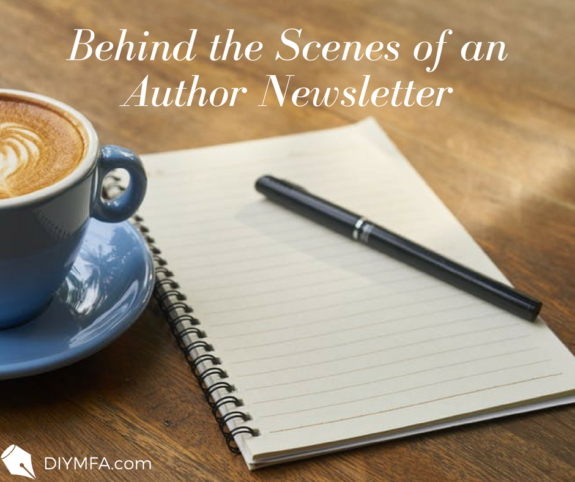As an author, your email list is your most valuable platforming asset. Why? Because it’s your most direct line to your biggest fans.
With so many platforming tools, your following is actually owned by the application you’re using. Consider: When you’re on Facebook, you have to play by Facebook’s rules. If they change their algorithm and say Page post reach will be reduced unless you pay for advertising to “Boost” it, you have no choice but to pay or be less visible. You can’t take that list of followers elsewhere.
But your email list is wholly yours. Even if you decide to stop using a specific email service, you still have that list and can do whatever you want with it.
This is awesome. And, well, it can also be daunting.
Once you have subscribers on your email list, what the heck are you supposed to do with them?
There are a lot of different answers to this question–as many answers as there are authors, one could argue. But I always find it helpful to know how other authors are doing things. So today I’m going to give you the grand tour of the monthly newsletter I send my own subscribers.
Application
Let’s start with the tools I use. I’m a MailChimp fan, and I feel it has served me well. It’s very user-friendly and, despite my being a total disaster at graphic design, I always feel confident that my newsletter looks great, because they make it easy.
However, as more competition to MailChimp crops up and my list grows, I have found MailChimp to be more expensive. I am currently exploring moving to MailerLite, which seems to function similarly and is less expensive.
ConvertKit is another great option, if you’re looking for something more sophisticated.
Schedule
It is important to have a regular schedule for your newsletter. Being reliable is just part of any healthy relationship, and when readers know to expect your email, they’re more likely to open it.
Anywhere between weekly and quarterly tends to be just fine, depending on what you share in each email, but for me, monthly is the right balance between staying frequent enough to stay top-of-mind with my readers, without overloading myself or annoying subscribers by pinging them constantly.
Content
In my opinion, there is no “wrong” way to do your newsletter. Let your voice shine through, and share a little bit of yourself. Make it long enough to offer some substance, but short enough to be skimmable and engaging.
If you’re stuck, look to other newsletters you’re addicted to, no matter if they’re publishing-related or not. I adore Anne Friedman and the Skimm, which share a smart and snarky voice with a little quirk. So I’ve tried to offer a bit of my own quirk in my newsletter both in its voice and in its structure:
- Status: In this top section, I share three action-oriented one-liners about what I’m up to at the moment. This can cover anything from my binge of Orange is the New Black, my ongoing sleep deprivation, or what I’m writing at the moment. As long as it’s short, sweet and crafted to entertain.
- Update: This is where I offer a little more substance with a few brief paragraphs. I kick it off with any publishing announcements I have, and then move on to tease and link to my recent blog posts. This is also where I offer occasional subscriber-only bonuses.
- Around the Web: I close out with another “quick bites” section, where I link to my top five favorite science fiction/fantasy/geek life articles from the previous month. They’re easy to grab, I just refer to my Twitter posts.
Subject Line
I used to have fun with my subject lines by giving each edition a quirky title. For example, I used ‘It Smells Like Snow’ Edition” in December, right after the new Gilmore Girls season released, and “Cue Up Another 365 Edition” at the beginning of January.
But then I did some beta testing and found that subject lines that offer a specific teaser to the content performed way better. So now I use lines like “Grab your golden lasso | Every comic book I read | AI in Dubai.”
I still like the “editions” more … but not as much as I like seeing that high engagement rate in my stats.
AB Testing
Speaking of A/B testing, I’m almost always running one. The subject line is a great one for this, and so it the release time. I’ve become obsessed with finding the most optimal time and day to push my newsletter out. Mailchimp makes this super easy, so don’t be afraid to use it liberally.
Every newsletter is a little different, and the best ones know their own voice and offer true substance.
It’s great to peek over another author’s shoulder, and I suggest you do a ton of it–really! I welcome you to join my email list even if you’re never going to read a fantasy book in your life. Follow several other authors too. Pay attention to what you like and what you don’t.
But ultimately, there is no substitute for knowing your brand and listening to your gut. Start from where you’re comfortable, be imaginative about it, and pay attention to those test results as you go.
What do you include in your author newsletter?
 By day, Emily Wenstrom, is the editor of short story website wordhaus, author social media coach, and freelance content marketing specialist. By early-early morning, she is E. J. Wenstrom, an award-winning sci-fi and fantasy author whose debut novel Mud was named 2016 Book of the Year by the Florida Writers Association.
By day, Emily Wenstrom, is the editor of short story website wordhaus, author social media coach, and freelance content marketing specialist. By early-early morning, she is E. J. Wenstrom, an award-winning sci-fi and fantasy author whose debut novel Mud was named 2016 Book of the Year by the Florida Writers Association.







